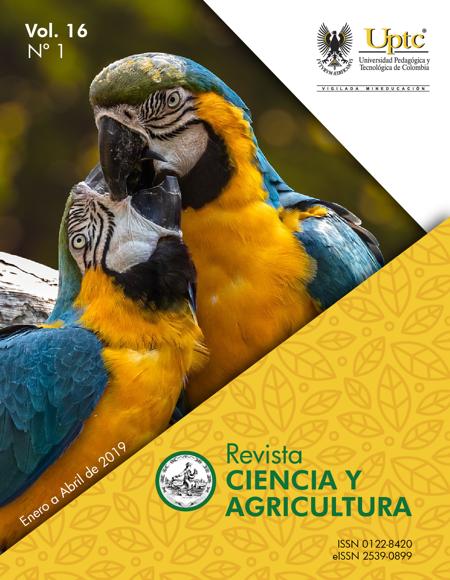Effect of fermented pumpkin (Cucúrbita pepo) on the productive and health parameters in pre-fattening pigs

Abstract
There were used 30 pre-fattening pigs of Yorkshire x Landrace hybrid, 7 kg average weight, during 42 days, coinciding between 33 to 76 days of the pigs´ age, with the objective of replacing the 0 (control); 15 and 30% of the conventional feed for the fermented pumpkin, according to completely randomized design with three treatments and ten repetitions, each baby was considered as a repetition. The concentration of yeasts in the pumpkin fermentation was determined, where an apparent stability in the concentration of these microorganisms was observed 21 days after the fermented was elaborated, while in the pigs the final live weight (27.30, 28.00 and 27.50 kg), the average daily gain (483, 502 and 488 g / day), the consumption of dry matter (30.37, 30.38 and 30.33 kg) and the conversion of dry matter (1.50, 1.44 and 1.48 kg DM / kg PV respectively) did not present a significant difference between the treatments evaluated; however, in the control treatment, there were more animals with diarrhea and mortality reached 10%; while in treatments that included fermented pumpkin, the rate of diarrhea was minimal and deaths were nil. It is concluded that pumpkin fermentation did not affect the productive indicators of pre-fattening pigs, while reducing the occurrence of diarrhea and avoiding deaths in this technological category.
Keywords
fermented food, pigs, yeasts
References
Anya, M. I., Ayuk, A. A., Umoren, E. P., Akpojovwo, V. A., & Ubua, J. (2011). Performance of weaned rabbit fed graded levels of African yam bean in cassava peel meal based diets. Continental J. Agricult. Sci., 5 (2), 25-30.
Balcázar, J. L., De Blas, I., Ruiz-Zarzuela, I., Vendrell, D., Cunningham, D., & Muzquiz, J. L. (2006). The role of probiotics in aquaculture. Veterinary Microbiology, 114, 173-186. DOI: https://doi.org/10.1016/j.vetmic.2006.01.009.
Brea, O., Elías, A., Ortiz, A., Herrera, F., & Motta, W. (2014). Utilización de la harina de frutos del árbol del pan (Artocarpus altilis) fermentada en estado sólido, en dietas destinadas a cerdos en preceba. Rev. Cubana de Cien. Agríc., 48(4), 391-398.
Brea, O. (2015). Obtención de un alimento energético-proteico a partir de la fermentación en estado sólido de la harina de frutos del árbol del pan y su empleo dietas para conejos y cerdos (Artocarpus altilis). Tesis Doctoral. Instituto de Ciencia Animal, Mayabeque, Cuba.
Camejo, A. I. (2013). Comportamiento reproductivo en cerdas de la UEB Cuba Sí 3 del municipio Holguín. Tesis de Maestría. Instituto de Ciencia Animal, Mayabeque, Cuba.
Castro, M., & Rodríguez, F. (2005). Levaduras: probióticos y prebióticos que mejoran la producción animal. Revista Corpoica, 6, 26-38. DOI: https://doi.org/10.21930/rcta.vol6_num1_art:33.
Cortés, L., & Gómez, F. (2011). Efficiency of microorganisms (EM) in the functional improvement of the digestive system of pigs in post-weaning phase. Revista Spei Domus., 25, 31-34.
Duncan, D. B. (1955). Multiple ranges and multiple F test. Biometrics, 11(1), 1-42. DOI: https://doi.org/10.2307/3001478.
FAO/WHO (2002). Report of a joint FAO/WHO working group on drafting guidelines for the evaluation of probiotics in food. Ontario, Canada. Disponible en: http://www.who.int/foodsafety/fs _management/en/probiotic_guidelines.pdf.
García, Y. (2011). Obtención de microorganismos con actividad probiótica a partir de excretas de pollos de ceba fermentadas. Tesis doctoral. Instituto de Ciencia Animal, Mayabeque, Cuba.
IBM (2009). Statistical Package for Social Sciences. New York.
Kim, E., Hong, H., Hong, N., Choi, K., Hann, Y., Kangwan, N., Chao, Y., & Hahn, K. (2012). Concentrated Probiotics Improve Inflammatory Bowel Diseases Better that Commercial Concentration of Probiotics. Journal of Food and Drug Analysis, 20, 292-295.
Lalles, J., Boudry, G., Favier, C., Le Floc’h, N., Lurona, I., Montagne, L., Oswald, I. P., Pie, S., Piel, C., & Seve, B. (2004). Gut function and dysfunction in young pigs: physiology. Animal Research, 53, 301-316. DOI: https://doi.org/10.1051/animres:2004018.
Ortiz, A., Gómez, S., Jay, O., & Brea, O. (2017). Inclusión del yogurt artesanal de leche de búfala en el pienso de gallinas ponedoras Isa Brown y su efecto en la producción y calidad del huevo. Ciencia y Agricultura, 14(1), 85-93. DOI: https://doi.org/10.19053/01228420.v14.n1.2017.6091.
Pluske, J., Hopwood, D., & Hampson, D. (2003). Relación entre la microbiota intestinal, el pienso, la incidencia de diarreas y su influencia sobre la salud del lechón tras el destete. En XIX Curso de Especialización FEDNA. Madrid, España.
Rodríguez, B. (2011). Levadura torula desarrollada sobre vinaza de destilerías para la alimentación de aves. Tesis doctoral. Instituto de Ciencia Animal, Mayabeque, Cuba.
Rodríguez, H. C., Barreto, G., Bertot, A., & Vázquez, O. (2013). Los microorganismos eficientes como promotores del crecimiento en los cerdos hasta el destete. REDVET. Revista Electrónica de Veterinaria, 14, 1-7.
Rodríguez, O., Martín, Y., García, A., & Núñez, M. (2015). Suero fermentado por lactobacillus casei y lactobacillus acidophilus con propiedades probióticas para cerdos jóvenes. En: V Congreso de Producción Animal Tropical. Palacio de las Convenciones, La Habana, Cuba.
Rondón, A., Ojito, Y., Arteaga, F., Laurencio, M., Milián, G., & Pérez, Y. (2013). Efecto probiótico de Lactobacillus salivarius C65 en indicadores productivos y de salud de cerdos lactantes. Revista Cubana de Ciencia Agrícola, 47, 401-407.
Yoo, I., Chang, H., Lee, E., Chang, Y., & Moon, S. (1997). Effect of B vitamin supplementation on lactic acid production by L. casei. Journal Fermentation Bioengineering, 84, 172-175. DOI: https://doi.org/10.1016/S0922-338X(97)82551-2.